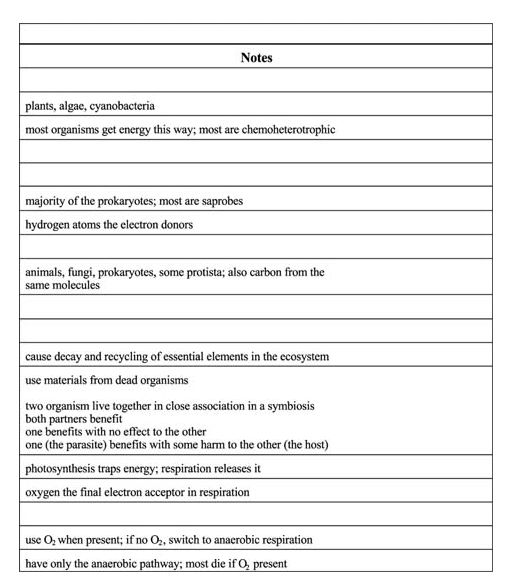Photosynthesis
Cyanobacteria. The blue-green algae, or cyanobacteria, are an important group of prokaryote photosynthesizers. They use the same pigment, chlorophyll a, as the green plants and have similar carotenoids, but in addition have accessory pigments calledphycobilins. One of these is blue, phycocyanin (the source of the group name), the other a dark red, phycoerythrin. (One group of cyanobacteria is common in northern and alpine areas where in spring they grow on the melting snow banks, turning them a deep pink color.) The chlorophylls are contained on thylakoid-like membranes with water the hydrogen donor, oxygen the by-product—as in plant photosynthesis.

The cyanobacteria are common in the marine plankton community (huge numbers of tiny aquatic organisms that float near the surface), and their presence in the early prokaryote world undoubtedly was a factor in changing the atmosphere from oxygen-free to oxygen-rich, paving the way for arrival of eukaryote oxygen users.
Purple and green bacteria. These bacteria are anaerobes, some of which use sulfur compounds as the electron donors (purple sulfur and green sulfur bacteria) and others of which use such organic compounds as alcohols and fatty acids (purple nonsulfur and green nonsulfur bacteria). Photosynthetic pigments include carotenoids and several bacteriochlorophylls, but no phycobilins. The green sulfur bacteria arephotolithoautotrophs because their energy comes from the sun (photo), their carbon from CO2 in the air (auto), their electrons from inorganic sulfur compounds or H2 gas (litho). Photosynthesis in the purple bacteria appears to be ancestral to Photosystem II of plants, that in the green bacteria a forerunner of Photosystem I.
Nitrogen cycle
The prokaryotes play a central role in the nitrogen cycle, not only in getting nitrogeninto the cycle, but getting it out as well. The actions of the prokaryotes drive the cycle. They mediate the following processes.
Nitrogen fixation. Prokaryotes are the only organisms capable of fixing atmospheric N2. That is, they form ammonia (NH2) from gaseous N2. The bacteria use some of the fixed nitrogen, and the remainder goes into the soil ecosystem for use by all. When the nitrogen-fixers die, their nitrogen-containing compounds are recycled by other organisms. Some nitrogen-fixers are chemoautotrophic soil bacteria, both anaerobes and aerobes, that either live free or else live symbiotically within the root nodules of legumes or in nodules of a few other plants. Cyanobacteria also live in lakes and ponds, in the oceans, and in numerous mutualistic relationships with fungi and plants, in lichen bodies, for example, or with cycads and ferns.
Nitrification. Nitrification is the two-step conversion of NH2 to nitrite (NO2−) and then to nitrate (NO3−). The energy released in the process is used by the chemolithoautotrophs to reduce CO2. Plants are able to assimilate nitrate, but nitrites are toxic to them.
Ammonification. Nitrogen mineralization or ammonification is the name of the process that the organisms of decay—chiefly saprophytic bacteria and fungi—use to decompose nitrogen-containing organic molecules, which release nitrogen as ammonia in the process. (Mineralization is the term for the conversion of organically bound nutrients into plant-available, inorganic forms, while decomposition is a more general term for the breakdown of organic matter.) Without mineralization the world would soon run out of raw materials for organisms, and life would cease. The nitrogen cycle turns because decay organisms exist.
Denitrification. Denitrification is the opposite of nitrogen fixing and nitrification; denitrifying bacteria return nitrogen to the atmosphere as N2O (nitrous oxide) or gaseous nitrogen (N2). Anaerobic bacteria carry out denitrification when oxygen diffuses too slowly through the soil to meet the microbial respiration demand. Nitrate replaces oxygen as the needed electron acceptor in these instances.
Extreme environments
The Archaea are divided into three large groups based on their physiological diversity. The methanogens are strict anaerobes that produce methane (CH4), halophiles are chemoorganotrophs that require 12–23 percent salt to grow, and one group ofthermophiles grows best at temperatures over 80°C, the other group at 0°C and lower. Pyrolobus grows at 113°C, the hottest known temperature to maintain an organism; Thermoplasma species combine low acidity and high temperature and live at pH 1–2 and temperatures of 60°C. The methanogens are the only organisms that produce methane. They use ammonium (NH4+) as a nitrogen source and get their carbon from CO2. The supplies of natural gas used today come from the metabolism of methanogens of the past, and all of the methane in the air today (around 1.6 ppm) comes from the metabolism of current methanogens.
The Archaea are more closely related to the eukaryotes than to the Bacteria and probably evolved later than the Bacteria. Our understanding of how many there are and where they live is limited. By virtue of their metabolic versatility, many live in remarkable environments—hot springs, hydrothermal vents at the bottom of the ocean, in the gut of cows, in vats of sulfuric acid, in sewage disposal tanks. Recent discoveries in soils of rRNA fragments with molecular sequences similar to those in theArchaea suggest that the Archaea may be more common than we now know.